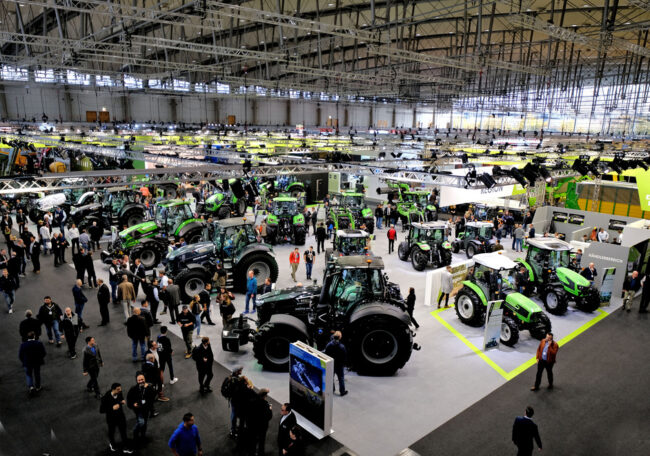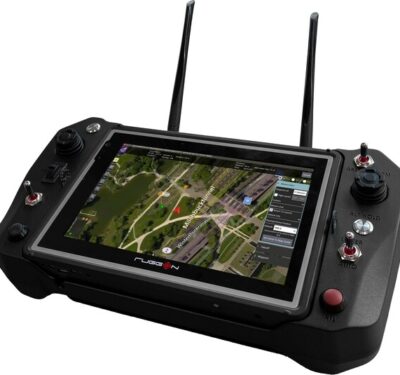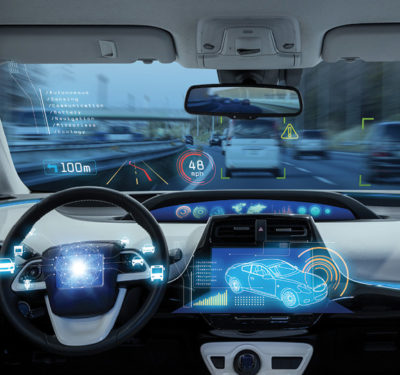
To the casual observer, Agritechnica 2023 probably looks a lot like the last edition of the Hanover, Germany agricultural equipment trade fair – a lot of big guys drinking big beers, admiring very big tractors.
Look into the cabins and under the hoods of some of those machines, however, and you’ll find an industry in transition, as autonomous features are integrated more and more deeply into a wider range of farming systems.
At the last Agritechnica, in 2019, the only smart farm implement was a baler, says James Szabo, Agriculture Autonomy Product Manager, NovAtel Autonomy & Positioning Division, for Hexagon, a geoanalytics provider. “The baler would say to the tractor, ‘I’ve made a bale, stop. Take it out, and drive off.’ That was about the only use case that people talked about,” he recalls.
This time around, a much wider range of farm implements are able to talk to the tractors pulling them, thanks to the number of developers who have integrated Agricultural Industry Electronics Foundation (AIEF) protocols into their systems. “The implement can say, slow down, and then the tractor will automatically slow down, and the implement can say I need to be lifted up, and then the tractor will activate the hydraulics and lift it up,” Szabo says.
Crucially, the tractor and the implement don’t need to belong to the same brand. Instead, the AIEF protocols are giving tractors and implements a common language, Szabo says, smoothing the transition to autonomy.
“The instrument manufacturers are understanding that adding technology onto their implements not only helps an operator today,” Szabo says. It also “means that farmers get used to the implements being clever.” That in turn means that jobs are being done more consistently, and down the line, “when the operator is removed, then that same communication can happen directly with the autonomous platform.”
The idea that sooner or later the operator will be removed seems to be taken for granted, but although tractors can already till entire fields on autopilot, most people interviewed see the transition as something that will happen gradually. “We’re less concerned right now with saying that we’ve got some magical device that’s going to do it all,” says Harlan Little, OEM Business Development Manager for Topcon Agriculture, an agricultural software company.
Instead, Little foresees a gradual shift. “I think it’ll be a lot like the adoption of automatic steering,” he says.
New advantages
In the meantime, however, some farmers are already gaining from advances in autonomous technology. Sales representatives for autonomous systems companies ticked off a number of ways farmers can benefit today from advances in sensors and autonomous features.
Topcon’s ultrasonic sensors, which until now have been used for height control for sprayers, have now been adapted to monitor for depth control, according to Little.
Meiko Martin, Business Development Director, Off-Road Autonomy for Trimble, a software and hardware company that supports agriculture and many other industries, says that it’s now possible to get an inexperienced operator to the level of an experienced operator within hours. At the same time, he says, autonomous features reduce wear and tear on the equipment.
The increasingly rich data harvest is another plus. Martin notes that Trimble’s system can help farmers make important decisions quickly, as field data is sent to the cloud and compared to current commodity prices. “Now, you can actually decide, should I increase my fertilizer based on the commodity price to get a higher yield, or is it nor worth doing?” he says.
In addition to incremental advances, more disruptive autonomous and unmanned systems were also on display at the fair. “We’re seeing a lot of movement away from R&D and startups to companies that are breaking out into production,” Szabo says.
One of those young companies is FarmDroid, a Vejen, Denmark developer whose FD20 autonomous seed-and-weed machine has been programmed to plant and weed more than 50 different crops. “If we can seed it, we can weed it,” says Rasmus Thuesen, Regional Sales Manager for FarmDroid.
The FD20 platform navigates by GPS that it calibrates against its own base station. It is equipped with only one camera, which the farmer can use for monitoring, but the rest of its work is done with GPS.
“When it does the seeding, it’s seeding each seed on a GPS point, so it knows exactly where all the seeds are located. Then afterwards, it can go back and do the weeding, and literally weed away everything except where the plant is,” explains Rasmus Thuesen, Regional Sales Manager for FarmDroid. The system is also precise enough that the machine’s spraying attachment can reduce the use of plant protection chemicals by up to 94%.
Solar-powered and capable of a top speed of 950 meters per hour, the platform can cover up to 6.5 hectares a day and operate 24 hours a day, seven days a week, Thuesen says.
Four hundred of FarmDroid’s machines are currently in operation around the world, according to Thuesen, including Australia, Canada, and Europe. The FarmDroid platform is legal almost everywhere, Thuesen says, except for California, because of some state rules about autonomous driving.
Picking your future
Other autonomous systems are looking further afield. A joint venture between Kubota and Tevel, an Israeli startup, promises to revolutionize fruit-picking, using tethered drones armed with suction cups, programmed to pick fruit based on size and color specifications.
While the Kubota-Tevel machine is still under development, another autonomous machine whose functionality includes apple picking, is already in production. Touted as a complete farming solution, Slopehelper is electrically powered and can be equipped with 13 different attachments, including a horizontal and vertical cutter for pruning branches both vertically and horizontally and an apple picking system that marketing materials say “imitates the movements of human hands.”
Developed by PeK Automotive of Vrhnika, Slovenia, the platform operates on continuous treads that can climb slopes of up to 42 degrees and perform tasks for the entire agricultural cycle, from planting to mulching.
Despite the hectares of new machinery all around the orange Slopehelper booth, Dr. Mikhail Kostkin, the CEO of PeK Automotive, argues that agricultural innovation isn’t moving as fast as it should. What’s holding it back?
Two reasons, Kostkin says. First, the tech boom, which he believes distracts technology entrepreneurs from solving problems that matter. “Say hello to NASDAQ — it doesn’t matter what you are doing. What’s important is to create a nice picture, a lot of kitsch. And after that, you are getting big money from nothing.”
Second, the agricultural industry, which he says is still fixated on the tractor, a 19th century concept that he says is out of sync with what 21st century people want. Kostkin argues that he could stop some young man in the hall and ask him, “Guy, do you want to be a tractor driver? What he will say? He will say no, are you crazy? That is not in my plan. But what if we would ask him, Do you want to be operator of robotic fleet? What answer will you hear? The answer will be yes, of course.”
Eventually, Kostkin believes that the industry will catch up with the times – at least some companies will. “You can ignore the future, yes, but in that case, the future will ignore you,” he warns darkly.
Photo credit: DLG






